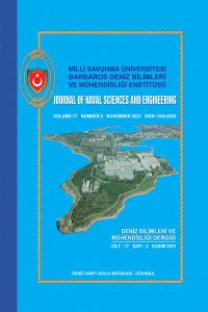HLA TABANLI DAĞITIK SİMULASYONDA SENARYO YÖNETİM UYGULAMALARI
Dağıtık simülasyon, yüksek seviye mimarisi, senaryo yönetimi, askeri senaryo tanımlama dili, federasyon geliştirme ve koşturma prosesi
Scenario Management Practices In HLA-Based Distributed Simulation
-,
___
- Topçu O. and Oğuztüzün H., “Developing an HLA Based Naval Maneuvering Simulation”, in Naval Engineers Journal (NEJ) by American Society of Naval Engineers (ASNE), vol.117 no.1, pp. 23-40, DOI: 10.1111/j.1559-3584.2005.tb00319.x, Winter 2005.
- IEEE 1516 Standard for Modeling and Simulation (M&S) High Level Architecture (HLA)-Framework and Rules, September 21, 2000.
- IEEE 1516.2 Standard for Modeling and Simulation (M&S) High Level Architecture (HLA)-Object Model Template Specification, September 21, 2000.
- IEEE 1516.1 Standard for Modeling and Simulation (M&S) High Level Architecture (HLA)-Federate Interface Specification, September 21, 2000.
- Simulation Interoperability Standards Organization (SISO), Standard for Military Scenario Definition Language (MSDL), SISO-STD-007-2008, October 14, 2008.
- Topçu O., “Naval Surface Tactical Maneuvering Simulation System Technical Report (Draft)”, manuscript, 2010.
- Hunt K., and Harten E., “A New Paradigm for Developing and Maintaining Scenarios for Distributed Simulation Systems”, 99S-SIW-179, in the Proceedings of the SISO Spring Simulation Interoperability Workshop (SIW), 1999.
- Savasan, H. and Oğuztüzün H., "Distributed Simulation of Helicopter Recovery Operations At Sea", Proceedings of Military, Government, and Aerospace Simulation (MGA02), Advanced Simulation Technologies Conference Simulation Series Volume 34 number 3 pp.120-125, April 2002.
- Microsoft XML Core Services (MSXML), “http://msdn.microsoft.com/en-us/library/ms760399(VS.85).aspx”, last accessed January 09, 2010.
- Ullner F., Lundgren A., Blomberg J., and Andersson N., “The Lessons Learned from Implementing a MSDL Scenario Editor”, 08F-SIW-001, in the Proceedings of Fall Simulation Interoperability Workshop (SIW), 2008.
- IEEE 1516.3 Standard for IEEE Recommended Practice for High Level Architecture (HLA) Federation Development and Execution Process (FEDEP), Apr 23, 2003.
- Topçu O., “Development, Representation, and Validation of Conceptual Models in Distributed Simulation”, Defence R&D Canada – Atlantic (DRDC Atlantic) Technical Memorandum (TM 2003-142), Halifax, NS, Canada, February 2004.
- Macannuco D. and Levan M., “Rapid Scenario Generation through Scripts”, 07S-SIW-021, in the Proceedings of Spring Simulation Interoperability Workshop (SIW), 2007.
- Fowler M., “UML Distilled 3rd Edition A Brief Guide to the Standard Object Modeling Language”, ISBN: 0-321-19368-7, Addison-Wesley, 2004.
- Brill M., Damm W., Klose J., Westphal B., and Wittke H., “Live Sequence Charts: An Introduction to Lines, Arrows, and Strange Boxes in the Context of Formal Verification”, Integration of Software Specification Techniques for Applications in Engineering (ISSN: 0302-9743), Springer Berlin Lecture Notes in Computer Science (LNCS) book series, vol.3147, pp. 374-399, 2004.
- Schmidt D.C., “Model-Driven Engineering”, IEEE Computer, vol.39 no.2, pp. 25-32, 2006.
- One Semi-Automated Forces, “ OneSAF’s MSDL implementation (Military Scenario Development Environment)”, http://www.onesaf.net/community/index.php?option=com_content&task=category§ionid=5&id=18&Itemid=36#18, last accessed January 30, 2010.
- Simulation Interoperability Standards Organization (SISO), Coalition Battle Management Language (C-BML), SISO-STD-008-20XX, http://www.sisostds.org/index.php?tg=articles&idx=More&article=439&topics=102, last accessed January 30, 2010.
- Blais C., Dodds R., Pearman J., and Baez F., “Rapid Scenario Generation for Multiple Simulations: An Application of the Military Scenario Definition Language (MSDL)”, 09S-SIW-003, in the Proceedings of Spring Simulation Interoperability Workshop (SIW), 2009.
- Lofstrand B., Karkkairen V., Strand J., ericsson M., Carmenta J., and Lepp H., “Scenario Management – Common Design Principles and Data Interchange Formats”, 04E-SIW-070, in the Proceedings of European Simulation Interoperability Workshop (SIW), 2004.
- ISSN: 1304-2025
- Yayın Aralığı: 2
- Başlangıç: 2003
- Yayıncı: Milli Savunma Üniversitesi Deniz Harp Okulu Dekanlığı
HLA TABANLI DAĞITIK SİMULASYONDA SENARYO YÖNETİM UYGULAMALARI
GÜÇ SİSTEMİ ÜZERİNDE RÜZGAR SANTRALLERİNİN ETKİLERİNİN DEĞERLENDİRİLMESİ
Wave Energy and Technical Potential of Turkey
Mustafa SAĞLAM, Egemen SULUKAN, Tanay Sıdkı UYAR
Nurturing the leader: Talent management in organizations
The Importance Of Customer Based Strategic Brand Equity Management For Enterprises
MÜŞTERİ MEMNUNİYETİNİN ÖLÇÜLMESİ: ZORUNLU MU? DEĞİL Mİ?
The Impact Of Strategic Human Resource Management On Organizational Performance
Implementation Of The Zero-Error One Second Timing Algorithm For Microcontroller
SÜREKSİZ SINIRLARA SAHİP, ÇİFT EĞRİLİKLİ, ÇAPRAZ KATLI LAMİNE KOMPOZİT KABUĞUN FOURIER ANALİZİ
